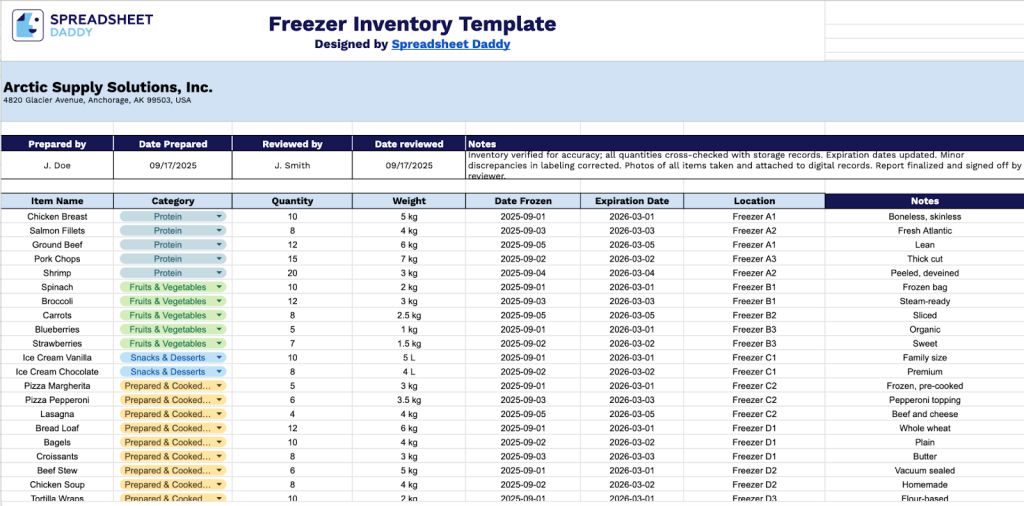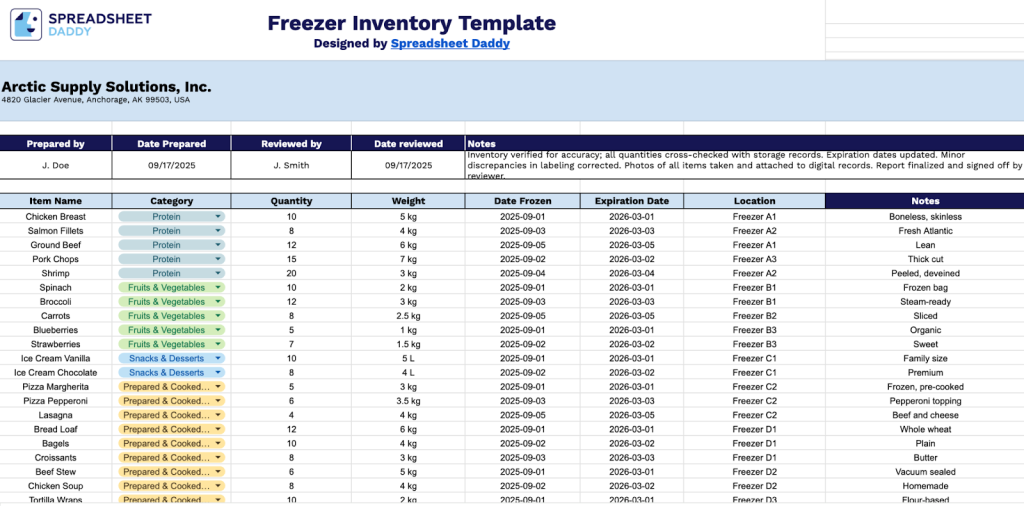Let’s be honest: we’ve all played the freezer archaeology game. You know the one where you dig through layers of frozen vegetables and mystery meat, hoping to find something edible for dinner tonight.
Maybe you’re the person who buys chicken breasts every grocery trip because you can never remember if you already have some. Or perhaps you’re still haunted by that expensive salmon fillet you discovered six months too late, transformed into an unrecognizable frozen brick.
Sounds familiar? You’re definitely not alone. Most of us treat our freezers like storage units we’d rather not think about until we absolutely have to.
That’s precisely why we created this free freezer inventory spreadsheet template, because life’s too short to waste good food or stress about what’s hiding behind the ice cream.
Quick Jump
ToggleWhat Is a Freezer Inventory Spreadsheet?

A freezer inventory spreadsheet is a simple way to keep track of everything in your freezer. You can note down what you have, how much, when you froze it, and when it expires, so nothing gets forgotten or wasted. It makes meal planning and grocery shopping much easier.
You can also add little notes, like storage tips or where the item came from, which helps keep your food fresh and organized. Whether it is for your family or a small business, it is a handy tool that saves time, money, and a lot of stress.
Why Use Our Freezer Inventory Spreadsheet Template?
- Never waste food again: Keep track of what you froze and when, so you’ll actually use those leftovers before they turn into mystery meat buried in the back of your freezer for months.
- Find what you need fast: Stop digging through frozen bags wondering what’s what. With everything categorized and labeled, you’ll know exactly where to find the chicken, vegetables, or that batch of soup you made last month.
- Thoughtful meal planning made easy: See what you have on hand at a glance, so you can plan meals around what’s already in your freezer instead of buying duplicates at the store.
- Keep your family safe: Track expiration dates so you’re not playing food safety roulette. Know when something needs to be used up or tossed out before it becomes a health hazard.
- Save money every month: Stop buying the same items over and over because you forgot you already had them. This simple tracking system pays for itself by preventing duplicate purchases and reducing food waste.
Download Spreadsheet Daddy’s Free Freezer Inventory Management Spreadsheet

This Freezer Inventory Template keeps it simple with space at the top for basic info: who filled it out, when, and any random notes you want to jot down.
The real magic happens in the seven columns, where you track everything that matters: what’s in there, what type of food it is, how much you have, what it weighs, when you put it in the freezer, when it’ll go bad, and where exactly you stored it.
It’s perfect for avoiding that “oops, I bought more ground beef when I already had five pounds” situation or the dreaded freezer burn discovery.
What’s included
- Smart accountability features: Right at the top, there is space for the person who filled it out, when they completed it, who double-checked their work, and when that occurred.
- Everything you need to track your frozen items: The main section features columns for the basics, including the item’s name, category, quantity, weight, freezing date, expiration date, storage location, and space for additional notes.
- Built with food safety in mind: Those date columns are not just there for show. They help you follow the “first in, first out” rule and avoid serving expired food.
- Room for the details that matter: Both the header notes and the item-level notes column give you space to jot down things like “defrost overnight” or “customer allergic to nuts,” those little reminders that can save your bacon, sometimes literally.
How to Use Our Freezer Inventory Spreadsheet Template
1. First, select your preferred format: download the Excel or PDF template, or create a copy of the Google Sheets document.
2. Input your firm’s name and address first, followed by the name of whoever prepared the inventory and the date it was finished. Record who reviewed it and when, and include any relevant observations or additional information in the notes section.

3. Following this, populate the fields with the relevant data:
- Item Name: Enter the specific name or description of the food item being frozen.
- Category: Select the type of food, such as protein, fruits & vegetables, prepared & cooked foods, dairy & alternatives, snacks & dessert, or other.
- Quantity: Record how many units or the amount of the item you’re storing
- Weight: Note the total weight of the item, typically in kilograms or pounds.
- Date Frozen: Enter the date when you placed the item in the freezer.
- Expiration Date: Record when the item should be used by for the best quality.
- Location: Specify where the item is stored in the freezer, such as on the top shelf or in the door.
- Notes: Include any additional details, such as preparation instructions or special storage requirements.
